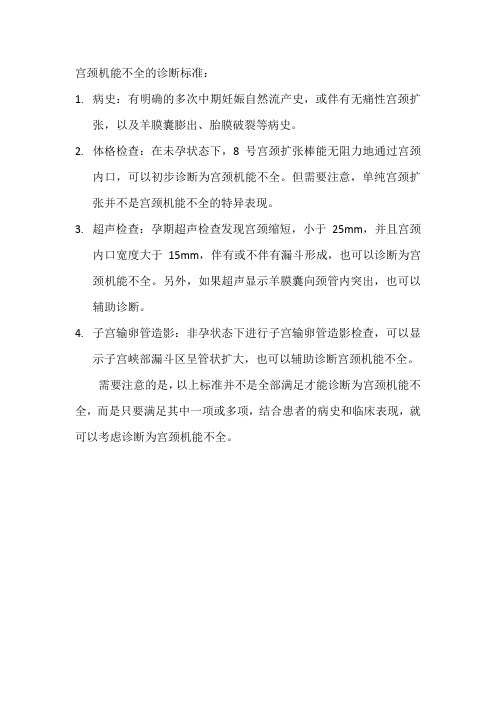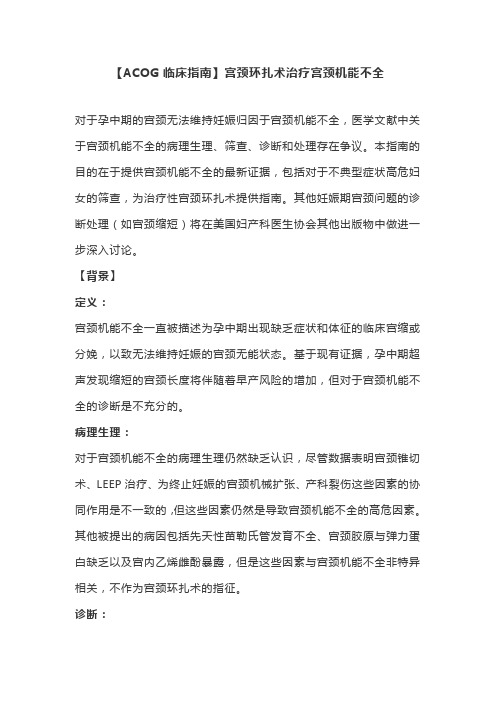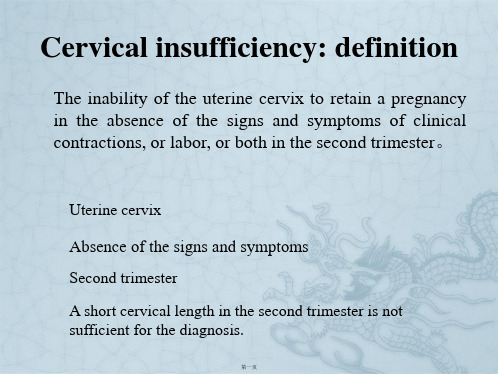宫颈机能不全指南解读
宫颈机能不全指南

手术治疗——经腹宫颈环扎术
• 诊断为宫颈机能不全,具有宫颈环扎术指征 • 由于解剖局限性无法经阴道手术患者的补救治疗(例如宫 颈切除术)--1965 Benson • 应用于经阴道环扎术失败导致孕中期妊娠流产的案例中 (C) ---1982 Novy
手术治疗——经腹宫颈环扎术
经腹/腹腔镜
• 经腹环扎术通常在早孕晚期、中孕早期(
主要内容
争议 指南
宫颈机能不全 病理生理 筛查 诊断 处理
不典型症状高危 妇女的筛查 宫颈环扎术的应 用
• 孕中期出现无症状无体征的宫缩或分娩,以致无法维持妊
娠的宫颈无能状态
• 出现无痛性宫口扩张、宫颈管缩短、羊膜囊膨出等
• 高危因素:宫颈锥切术、LEEP、终止妊娠时的宫颈机械 扩张(多次的人流、清宫)、产科裂伤(文献报道 与宫颈机 能不全的相关性 结论不一致)
相对风险高3倍;另外,长期卧床休息亦容易导致孕妇肌肉不协调、肺功能失 调、心理挫折、家族压力等并发症。 • 结论:由于孕期卧床休息已被证实缺乏益处且存在副作用,被认定是一个违 反医学伦理的处方,只建议局限在知情同意下的临床试验中有条件被使用。
McCall CA, Grimes DA, Lyerly AD. “Therapeutic” bed rest in pregnancy: unethical and unsupported by data. Obstet Gynecol 2013;121:1305–8. Available at:
孕10-14周)或者非孕期实施手术。缝线能
够在妊娠期保留至剖宫产后。
腹腔镜下宫颈环扎术
file://localhost/Volumes/KINGSTON/宫颈机能不 全/腹腔镜下宫颈环扎(中山大学附属第一医院 姚书忠教授).mpg
《子宫颈机能不全临床诊治中国专家共识(2023年版)》全文内容解读ppt课件【30页】

06
子宫颈机能不全的遗传与预 防
遗传因素
子宫颈机能不全有家族聚集现象
部分患者存在家族遗传史,其一级亲属患病风险较普通人群增加2-3倍。
基因突变与子宫颈机能不全相关
已发现多种基因突变与子宫颈机能不全发病有关,如胶原蛋白基因、成纤维细胞 生长因子受体基因等。
预防策略
加强遗传咨询与生育建议
对具有家族遗传史的孕妇,建议其在妊娠前进行遗传咨询, 并充分了解妊娠后子宫颈机能不全的风险,以制定针对性的 预防措施。
妊娠后宫颈评估与处理
对于有高危因素的孕妇,建议在妊娠早期进行宫颈评估,包 括超声检查宫颈长度、宽度及内口宽度等,以预测发生子宫 颈机能不全的可能性。
高危人群的管理
针对高危人群进行密切监测
对存在子宫颈机能不全高危因素的孕妇,建议在妊娠中期(16-20周)开始 密切监测宫颈情况,如间隔2-4周进行超声检查等。
由于CIN的发病机制尚未完全明确,临床表现缺乏特异性,诊 断方法和治疗策略尚不统一,因此,制定一份全面、科学、 实用的《子宫颈机能不全临床诊治中国专家共识(2023年版 )》旨在提高CIN诊疗水平。
共识的制定与发布
共识的制定
由中华医学会妇产科学分会组织专家撰写,经过反复讨论、 修改和终审,最终由中华医学会妇产科学分会发布。
进一步研究不同治疗方法的适用范围和优缺 点,提出更加合理的治疗方案。
加强对子宫颈机能不全患者的长期随访和预 后评估,为患者提供更加全面的诊疗服务。
THANKS
诊断方法
病史和临床表现
妇科检查
详细了解患者的生育史、流产史、早产史等 ,以及是否存在下腹痛、腰酸、阴道流血等 临床表现。
通过妇科检查可以观察宫颈的形态、长度和 宽度,以及宫颈内口宽度和形态的变化情况 。
宫颈机能不全 诊断标准

宫颈机能不全的诊断标准:
1.病史:有明确的多次中期妊娠自然流产史,或伴有无痛性宫颈扩
张,以及羊膜囊膨出、胎膜破裂等病史。
2.体格检查:在未孕状态下,8号宫颈扩张棒能无阻力地通过宫颈
内口,可以初步诊断为宫颈机能不全。
但需要注意,单纯宫颈扩张并不是宫颈机能不全的特异表现。
3.超声检查:孕期超声检查发现宫颈缩短,小于25mm,并且宫颈
内口宽度大于15mm,伴有或不伴有漏斗形成,也可以诊断为宫颈机能不全。
另外,如果超声显示羊膜囊向颈管内突出,也可以辅助诊断。
4.子宫输卵管造影:非孕状态下进行子宫输卵管造影检查,可以显
示子宫峡部漏斗区呈管状扩大,也可以辅助诊断宫颈机能不全。
需要注意的是,以上标准并不是全部满足才能诊断为宫颈机能不全,而是只要满足其中一项或多项,结合患者的病史和临床表现,就可以考虑诊断为宫颈机能不全。
宫颈机能不全的诊断及治疗

宫颈机能不全的诊断及治疗宫颈机能不全(Cervical Incompetence)是指宫颈缺乏足够的结构强度,不能承受妊娠期子宫重量和内压,宫颈口开始早期开放,时限在24周以前,导致早产或流产的一种疾病。
由于宫颈机能不全的诊断精确率不高,且治疗方法也存在争议,因此我们需要深入了解宫颈机能不全的诊断及治疗。
一、宫颈机能不全的病因和诊断病因宫颈机能不全的病因主要与以下因素有关:1.先天性宫颈发育异常2.外伤、手术等宫颈损伤史3.子宫颈导管畸形4.感染、炎症导致子宫颈松弛5.孕前刮宫、人工流产等手术史诊断宫颈机能不全的诊断主要依靠以下几项指标:1.孕史:孕次、妊娠次数、早产和晚期流产史等。
2.体格检查:包括宫颈形态、张力和宫口大小等。
3.超声检查:子宫颈长度、开口度、形态等。
4.胎膜腔置入宫颈环:来评估子宫颈的承受力。
5.眼窝囊肿。
二、宫颈机能不全的治疗宫颈机能不全的治疗方法主要包括以下几种:1. 保守治疗保守治疗适用于子宫颈已经短小,但尚未短到需要紧急手术的情况下。
具体治疗内容如下:1.完全卧床休息。
保持膀胱和肠道无压力,每天足够的休息和睡眠时间。
2.使用松弛剂。
口服或阴道给药,以减轻宫颈的收缩。
3.抗生素治疗。
如果发现感染,推荐使用抗生素治疗。
4.支架治疗。
使用宫颈环或其他类型的支架,以防止宫颈局部进一步扩张。
5.孕期管理。
提前诊断 ,定期检查,密切监测胎儿发育情况。
2. 手术治疗手术治疗适用于宫颈口已经开放到需要手术干预的程度。
手术治疗包括以下几种:1.子宫颈环扎。
手术将皮下半部分或全部宫颈环扎紧,形成人工狭窄的子宫颈,达到支持妊娠子宫的效果。
2.阴道-宫颈胶原整形术。
将人工材料或者自体组织修复宫颈,形成一个有结构强度支持的宫颈。
3.腹腔宫颈管缩小术。
手术缩小腹腔内的子宫颈管,以防止宫缩与宫颈口开离。
4.开腹式子宫颈扎缩松解术。
手术将宫颈口环扎,缝合宫颈缩小,然后去除环扎,增加宫颈管的张力。
三、宫颈机能不全的预防尽管根据目前的科学研究还没有找到可以预防宫颈机能不全的方法,但是以下一些措施可以建议妊娠期女性采取,帮助降低患宫颈机能不全的风险:1.提前进行膳食营养的筛查和补充。
《ACOG宫颈环扎术治疗宫颈机能不全指南》解读

《ACOG宫颈环扎术治疗宫颈机能不全指南》解读夏恩兰【摘要】宫颈机能不全(cervical incompetence,cervical insufficiency,incompetent cervix)是临床诊断性疾病,但其诊断十分模糊,缺乏客观的金标准。
医学文献中关于宫颈机能不全的病理生理、筛查、诊断和处理存在争议。
2014年2月美国妇产科学会(The American College of Obstetricians and Gynecologists,ACOG)颁布了宫颈环扎术治疗宫颈机能不全指南文件,具有较强的临床实用性。
该指南系统复习和汇总了有关宫颈机能不全的定义、病因、诊断、治疗选择中非手术治疗方法及手术治疗,手术的临床注意事项与建议,不宜推荐宫颈环扎术的病情,宫颈环扎术的并发症,增加围手术期干预及术后B超随访评估的意义,无并发症McDonald术拆除缝线的时机,未足月前胎膜早破宫颈环扎缝线拆除与保留的选择及早产宫颈环扎缝线拆除与保留的选择等问题的文献依据及证据等级。
笔者指出国内目前尚无治疗宫颈机能不全的指南,一般比较强调卧床休息和宫颈环扎手术治疗,欧美国家对宫颈环扎手术的施行,较国内妇产科医生更为慎重。
%Cervical incompetence (cervical insufficiency, incompetent cervix) is a clinical diagnosis disease. However, the diagnosis is very fuzzy, lack of objective gold standard. In the medical literature on cervical incompetence its pathological physiology, screening method, diagnosis and treatment is controversial. The United States in February 2014, The American College of Obstetricians and Gynecologists (ACOG) has issued guidelines of the cervical cerclage treatment for cervical incompetence, which is much strong clinical practicability. In this paper, the literature basis and the level of evidence was shown by systematic review and summary about thedefinition of the cervical incompetence, etiology, diagnosis, treatment options among nonsurgical and surgical modalities, the candidates should not be considered for cervical cerclage morbidity of cervical cerclage, the role of postoperative ultrasonographic assessment for additional perioperative interventions, time of remove sewing material for transvaginal McDonald cerclage indicated in patients with no complications, the time of remove out sewing silk of women with cerclage and preterm premature rupture of membranes should be managed. Should cerclage be removed in women with preterm labor etc. Points out that at present there is no guideline for the treatment of cervical incompetence in China, in general more emphasis on bed rest and cervical cerclage operation. Compared with obstetrician and gynecologist in China , European and American doctors is more careful for cervical cerclage surgery.【期刊名称】《国际妇产科学杂志》【年(卷),期】2016(043)006【总页数】5页(P652-656)【关键词】宫颈功能不全;流产;超声检查;环扎术,宫颈【作者】夏恩兰【作者单位】100038 北京,首都医科大学附属复兴医院宫腔镜中心【正文语种】中文宫颈机能不全又称子宫颈内口闭锁不全、子宫颈口松弛症、宫颈功能不全(cervical incompetence,cervical insufficiency,incompetent cervix),是指妊娠后,在达到足月妊娠前宫颈展平、变薄,宫颈管扩张、变宽的临床状态,最终导致中期妊娠流产或早产。
【ACOG临床指南】宫颈环扎术治疗宫颈机能不全

【ACOG临床指南】宫颈环扎术治疗宫颈机能不全对于孕中期的宫颈无法维持妊娠归因于宫颈机能不全,医学文献中关于宫颈机能不全的病理生理、筛查、诊断和处理存在争议。
本指南的目的在于提供宫颈机能不全的最新证据,包括对于不典型症状高危妇女的筛查,为治疗性宫颈环扎术提供指南。
其他妊娠期宫颈问题的诊断处理(如宫颈缩短)将在美国妇产科医生协会其他出版物中做进一步深入讨论。
【背景】定义:宫颈机能不全一直被描述为孕中期出现缺乏症状和体征的临床宫缩或分娩,以致无法维持妊娠的宫颈无能状态。
基于现有证据,孕中期超声发现缩短的宫颈长度将伴随着早产风险的增加,但对于宫颈机能不全的诊断是不充分的。
病理生理:对于宫颈机能不全的病理生理仍然缺乏认识,尽管数据表明宫颈锥切术、LEEP治疗、为终止妊娠的宫颈机械扩张、产科裂伤这些因素的协同作用是不一致的,但这些因素仍然是导致宫颈机能不全的高危因素。
其他被提出的病因包括先天性苗勒氏管发育不全、宫颈胶原与弹力蛋白缺乏以及宫内乙烯雌酚暴露,但是这些因素与宫颈机能不全非特异相关,不作为宫颈环扎术的指征。
诊断:断基于早孕晚期无痛性宫颈扩张、继之孕中期妊娠物排出的病史,典型病例发生在孕24周前,且无宫缩、产兆和其他明确的病理因素(如流血、感染、破膜)。
最近尝试使用孕中期评估宫颈长度和识别宫颈短缩作为宫颈机能不全的超声诊断标志。
然而短宫颈通常是作为早产的标志而不是宫颈机能不全的特殊标志。
尽管如此,当发现短宫颈时,宫颈环扎术在特定情形下仍然是有效的(稍后文献将做进一步讨论)。
各种非孕妇女的诊断性试验建议用于确定宫颈机能不全的存在,包括子宫输卵管造影术、宫颈球囊牵引摄像、应用Hegar或Pratt宫颈扩张器评估宫颈扩张情况、球囊回弹试验和宫颈扩张分级计算宫颈阻力指数。
然而没有任何一个试验是被严格的科学研究验证的,都不能用作诊断宫颈机能不全。
治疗选择:历史上,若干手术和非手术治疗方法被用于治疗宫颈机能不全。
宫颈机能不全.

·
大致有如下几种:(1)分娩损伤。分娩、手 术产时扩张宫颈均引起子宫颈口损伤,如 急产、巨大儿、子宫口未开全行臀位牵引 术、产钳术等。(2)人工流产时扩张宫颈过 快过猛。近年来由于早孕人工流产及中孕 引产的增加,创伤性宫颈功能不全的发生 率不断上升。(3)宫颈楔形切除术后。(4)子 宫颈发育不良。
谢谢
宫颈机能不全的诊断
诊断宫颈机能不全可根据病史、临床表 现及B超检查结果。 只要有反复中晚期流产、早产史,流产前 无先兆症状,胎儿娩出极快,要高度怀疑 宫颈机能不全。
但在超声检查时,要密切结合病史及临 床表现,以免因断面的选取不一致测量误 差造成错误。
宫颈机能不全的治疗
治疗方法一般都主张在孕14-18周期间进 行子宫颈内口环扎术。术后卧床休息,给 黄体酮、维生素E以及镇静药,能维持到 妊娠足月。手术成功率可达90%。
引起宫颈机能不全的原因很多
宫颈口的肌肉和结缔组织的走向呈螺旋 状,就好像扎麻袋口的绳结一样,具有括 约作用。其功能是受性激素的调节,雌激 素会使括约作用松弛,孕激素促使宫颈内 口肌肉收缩因此,在孕激素占优势的妊娠 期间宫颈内口的括约作用有所增强。如果 括约功能发生障碍,就可能导致宫颈内口 松弛而发生流产。
宫颈机能不全
宫颈机能不全的定义:
亦称子宫颈内口闭锁不全、子宫颈口 松弛症。宫颈功能不全患者的宫颈含纤维 组织、弹性纤维及平滑肌等均较少,或由 于宫颈内口纤维组织断裂,峡部括约肌能 力降低,使宫重复性流产,反 复流产者发生率为8%~15%。
宫颈机能不全的诊断标准

宫颈机能不全的诊断标准宫颈机能不全是指宫颈内口松弛,宫颈管过短,宫颈功能不全,易于在妊娠中期或晚期发生宫颈松弛,导致早产或流产。
宫颈机能不全的诊断对于预防和治疗相关并发症具有重要意义。
下面将介绍宫颈机能不全的诊断标准。
一、病史。
1. 孕次,多次妊娠,早产或自然流产史。
2. 早产史,有早产史,尤其是多次早产史。
3. 人工流产史,有多次人工流产史,尤其是宫颈口扩张术史。
4. 宫颈手术史,有宫颈锥切术或其他宫颈手术史。
二、体格检查。
1. 宫颈外口,宫颈外口松弛,内口松弛或宫颈管短小。
2. 宫颈管,宫颈管松软,宫颈管长度短于正常。
三、宫颈功能检查。
1. 宫颈管功能检查,宫颈管功能不全,宫颈管松弛度增加。
2. 宫颈口功能检查,宫颈口张力不足,松弛度增加。
四、宫颈形态检查。
1. B超检查,宫颈管短小,宫颈内口松弛。
2. 子宫颈管造影,宫颈管短小,宫颈管形态异常。
五、宫颈组织病理学检查。
1. 宫颈组织活检,宫颈组织松弛,纤维组织减少。
2. 宫颈黏液检查,宫颈黏液量增加,宫颈黏液质地变化。
六、其他相关检查。
1. 早孕期宫颈松弛监测,早孕期宫颈松弛监测异常。
2. 宫颈功能相关激素检查,宫颈功能相关激素异常。
综上所述,宫颈机能不全的诊断标准主要包括病史、体格检查、宫颈功能检查、宫颈形态检查、宫颈组织病理学检查以及其他相关检查。
通过综合分析这些方面的检查结果,可以对宫颈机能不全进行准确的诊断,为后续的预防和治疗提供重要依据。
对于有宫颈机能不全症状的孕妇,及早进行诊断并采取相应的预防措施,有助于降低早产和流产的风险,保障母婴健康。
宫颈机能不全的诊断和处理操作培训

汇报时间:XXX年XX月 培训人:五英里小屋
目录
第一部分 定义 第二部分 诊断
CONTENTS
第三部分 治疗 第四部分 护理
第一部分 定义
宫颈机能不全的定义
ABOUT US
针对宫颈机能不全(cervical incompetence,CIC)目前尚无明确定义,通常指足月妊娠前出现的宫颈 管缩短、宫颈口扩张、最终无法维持正常妊娠等异常,其发生率约0.1%~1.0%。临床诊断CIC主要 根据病史(反复出现的中期妊娠流产或早产史)、超声检查和典型临床表现。超声早期评估CC能客观 反映宫颈情况,对个性化孕前干预、孕期管理及改善不良妊娠结局具有重要意义。
Page 16
Thanks! 谢谢聆听
第四部分 护理
术后护理
1. 卧床休息,必要时抬高床尾,垫高患者臀部 2. 保持外阴清洁 3. 指导患者饮食,保持大便通畅 4. 避免增加腹压的活动及体力劳动 5. 常规给予抗生素预防感染,有血性分泌物者延长
抗生素使用时间
Page 15
缝线拆除时机
1. 有明显宫内感染迹象 2. 难免流产 3. 早产临产 4. 胎膜早破 5. 孕周达36~37周 6. 对于有阴道分娩禁忌者,在剖宫产Q术中同时拆除环扎线
②后天因素,主要指宫颈损伤如清宫、宫腔镜检查造成的宫颈撕 裂伤以及冷刀活检、宫颈环形电切术所致宫颈括约肌功能受损。
③此外,自身免疫异常亦可能与发生CIC有关,CIC孕妇抗核抗体 及抗心磷脂抗体高表达。
Page 6
二部分 诊断
宫颈机能不全的诊断
宫颈机能不全的诊断主要是:
1、妊娠中期反复自然流产早产史
2、经阴B超测量宫颈内口宽度、宫 颈长度
【ACOG临床指南】宫颈环扎术治疗宫颈机能不全

【ACOG临床指南】宫颈环扎术治疗宫颈机能不全对于孕中期的宫颈无法维持妊娠归因于宫颈机能不全,医学文献中关于宫颈机能不全的病理生理、筛查、诊断和处理存在争议。
本指南的目的在于提供宫颈机能不全的最新证据,包括对于不典型症状高危妇女的筛查,为治疗性宫颈环扎术提供指南。
其他妊娠期宫颈问题的诊断处理(如宫颈缩短)将在美国妇产科医生协会其他出版物中做进一步深入讨论。
【背景】定义:宫颈机能不全一直被描述为孕中期出现缺乏症状和体征的临床宫缩或分娩,以致无法维持妊娠的宫颈无能状态。
基于现有证据,孕中期超声发现缩短的宫颈长度将伴随着早产风险的增加,但对于宫颈机能不全的诊断是不充分的。
病理生理:对于宫颈机能不全的病理生理仍然缺乏认识,尽管数据表明宫颈锥切术、LEEP治疗、为终止妊娠的宫颈机械扩张、产科裂伤这些因素的协同作用是不一致的,但这些因素仍然是导致宫颈机能不全的高危因素。
其他被提出的病因包括先天性苗勒氏管发育不全、宫颈胶原与弹力蛋白缺乏以及宫内乙烯雌酚暴露,但是这些因素与宫颈机能不全非特异相关,不作为宫颈环扎术的指征。
诊断:断基于早孕晚期无痛性宫颈扩张、继之孕中期妊娠物排出的病史,典型病例发生在孕24周前,且无宫缩、产兆和其他明确的病理因素(如流血、感染、破膜)。
最近尝试使用孕中期评估宫颈长度和识别宫颈短缩作为宫颈机能不全的超声诊断标志。
然而短宫颈通常是作为早产的标志而不是宫颈机能不全的特殊标志。
尽管如此,当发现短宫颈时,宫颈环扎术在特定情形下仍然是有效的(稍后文献将做进一步讨论)。
各种非孕妇女的诊断性试验建议用于确定宫颈机能不全的存在,包括子宫输卵管造影术、宫颈球囊牵引摄像、应用Hegar或Pratt宫颈扩张器评估宫颈扩张情况、球囊回弹试验和宫颈扩张分级计算宫颈阻力指数。
然而没有任何一个试验是被严格的科学研究验证的,都不能用作诊断宫颈机能不全。
治疗选择:历史上,若干手术和非手术治疗方法被用于治疗宫颈机能不全。
SOGC《宫颈机能不全与宫颈环扎术临床实践指南》解读

SOGC《宫颈机能不全与宫颈环扎术临床实践指南》解读宫颈机能不全(cervical incompetence,CIC)系宫颈解剖结构或功能异常,导致在足月妊娠前出现进行性、无痛性宫颈缩短、扩张、展平及漏斗状宫颈,妊娠中晚期无法维持妊娠,发生率为0.1%~1.0%。
是复发性中晚期妊娠流产及早产的重要原因。
作为临床诊断性疾病,CIC缺乏客观的诊断标准,宫颈环扎术是目前治疗宫颈机能不全的惟一术式和有效方法。
2019年加拿大妇产科医师协会(S OGC)颁布了最新版指南《No.373宫颈机能不全与宫颈环扎术临床实践指南》,替代2013年No.301旧版指南,旨在指导临床医生明确宫颈机能不全的高危人群,并为宫颈环扎手术术式及辅助治疗措施的个体化选择提供参考意见。
本文就该指南的推荐意见进行简要解读。
1 指南主要更新1.1 多胎妊娠1.1.1 双胎妊娠早产的预防双胎妊娠早产的预防中,子宫托并未显出明显优势;即使合并宫颈短的患者也未能由此获益。
1.1.2 预防性宫颈环扎术预防性宫颈环扎术对于宫颈长度<25mm的双胎妊娠患者并无显著益处,反而有可能增加早产风险,这一点更新的研究数据同既往结论一致。
但对于宫颈长度<15mm的“宫颈极短”者,环扎手术可能是有利的,仍需进一步研究证实。
1.1.3 紧急宫颈环扎术当宫颈管扩张>1cm时,无论多胎还是单胎妊娠,行紧急宫颈环扎术对患者均有潜在获益价值。
1.2 单胎妊娠研究表明,对于仅有过1次中期妊娠流产史的患者,行宫颈环扎手术可能增加早产、围产儿发病及死亡的风险。
2 指南推荐建议指南推荐如下:(1)妊娠或计划妊娠的女性应进行宫颈机能不全的危险因素评估。
全面的病史回顾将有助于临床医生发现患者首次妊娠的危险因素(Ⅲ-B)。
(2)特别强调对于既往有中期妊娠流产或极早产史的女性应进行详细的危险因素评估(Ⅲ-B)。
(3)有宫颈机能不全病史的女性,首次产检即应行尿液分析、阴道分泌物培养及药敏实验,发现任何感染均应先行治疗(Ⅰ-A)。
宫颈机能不全指南解读

Cervical insufficiency: treatment options
Non-surgical treatment
1. Vaginal progesterone 2. Vaginal pessary
3. Activity restriction
4. Bed rest
5. Pelvic rest
第十一页
Ultrasound-indicated cerclage
Cerclage versus no cerclage in patients with short cervical length
第十二页
Questions 2: Which patients should not be considered candidates for cerclage?
4.Transabdominal cerclage carries a much greater risk of hemorrhage .
第十四页
Questions 4: Is there a role for additional perioperative interventions and postoperative ultrasonographic assessment with cerclage placement?
c. Assessment of the patulous cervix with Hegar or Pratt dilators d. Balloon elastance test
e. Cervical dilators to calculate a cervical resistance index
2. Transvaginal cervical cerclage procedures can not place because of anatomicafficiency: clinical considerations and recommendations
宫颈机能不全

宫颈功能不全的表现
• 宫颈功能不全的表现主要是早产及 中、晚期重复性流产,反复流产者 发生率为8%~15% 。
• 宫颈机能不全所致流早产,约占所有妊 娠的 0. 05% ~1. 8%,约有 20%发生在 妊娠 13 ~27 周。
术。McDonald 法则为在宫颈与阴道交界处,至少应 进入 2/3 以上肌层深度,但不能穿透黏膜,环形绕 宫颈缝 4 ~5 针,注意避开两侧血管,然后打结, 使宫颈内口缩小,但能通过 4 号 Hegar 扩张器。
• 改良 Shirodkar 法是宫颈阴道前壁黏膜切开, 后壁不切开,按左后→左前→右前→右后顺序 完成环扎缝合,在宫颈阴道后方打结。连续缝 合切开的阴道黏膜。
保持患者大便通畅,防止便秘,必要时用开塞 露。
同时,术后常规静滴 25% 硫酸镁 40 ~ 60ml,连续 3 天( 紧急宫颈环扎术后可增 加剂量和时间) ; 常规给抗生素预防感染, 有血性分泌物者延长抗生素应用时间。如 无异常改宫缩抑制剂口服。
一般认为如有剖宫产指征者可在行剖宫产 术中拆除缝线。计划经阴分娩者可在妊娠 37 ~38 周拆除缝线。如有胎膜早破、宫缩、 阴道出血、有感染迹象应及时拆线。
• 在没有高危因素的孕妇中,CL < 25mm 早产的发生率是 4%,CL 阳性预测值 ( PPV) 是 18%,对于低危的孕妇,连续
的超声宫颈筛查不应列为常规。即使是 高危的患者,妊娠早期或中期的早期 CL 也是正常的,在妊娠 10 ~14 周只有 5% 的宫颈长度小于 25mm。
宫颈机能不全的处理
1 经阴宫颈环扎术 1955 年,印度孟买 Shirodkar 用患者大腿的阔筋膜进行了
- 1、下载文档前请自行甄别文档内容的完整性,平台不提供额外的编辑、内容补充、找答案等附加服务。
- 2、"仅部分预览"的文档,不可在线预览部分如存在完整性等问题,可反馈申请退款(可完整预览的文档不适用该条件!)。
- 3、如文档侵犯您的权益,请联系客服反馈,我们会尽快为您处理(人工客服工作时间:9:00-18:30)。
e. Cervical dilators to calculate a cervical resistance index
Cervical insufficiency: treatment options
Non-surgical treatment
1. 2. 3. 4. 5. Vaginal progesterone Vaginal pessary Activity restriction Bed rest Pelvic rest
Diagnostic tests should not be used to diagnose cervical insufficiency.
a. Hysterosalpingography
b. Radiographic imaging of balloon traction on the cervix c. Assessment of the patulous cervix with Hegar or Pratt dilators d. Balloon elastance test
Cervical insufficiency: clinical considerations and recommendations
1. Cerclage placement may be indicated based on a history of cervical insufficiency, physical examination findings, or a history of preterm birth and certain ultrasonographic findings. 2. Cerclage should be limited to pregnancies in the second trimester before fetal viability has been achieved.
Cerclage for the Management of Cervical Insufficiency
Cervical insufficiency: definition
The inability of the uterine cervix to retain a pregnancy in the absence of the signs and symptoms of clinical contractions, or labor, or both in the second trimester。
1. Low risk of complications with cerclage placement. 2. Incidence of complications varies widely in relation to the timing and indications for the cerclage. 3. Life-threatening complications of uterine rupture and maternal septicemia are rare but have been reported. 4.Transabdominal cerclage carries a much greater risk of hemorrhage .
In most cases, removal of a McDonald cerclage in the office setting is appropriate.
2. Further ultrasonographic surveillance of cervical length after cerclage placement is not necessary.
Questions 5: When is removal of transvaginal McDonald cerclage indicated in patients with no complications, and what is the appropriate setting for removal?
3. Evidence is lacking for the benefit of cerclage solely for the following indications: prior LEEP, cone biopsy, or mü llerian anomaly.
Questions 3: Is cerclage placement associated with an increase in morbidity?
1. Short cervical length without history of prior singleton preterm birth. Vaginal progesterone is recommended to prevent cervical length ≤ 20mm before 24 wks. 2. Twin pregnancy with cervical length ≤ 25 mm.
One in three RCT indicated fewer deliveries before 33 weeks of gestation in the cerclage group.
Physical Examination-Indicated Cerclage
Given the lack of larger randomized trials that have demonstrated clear benefit, women should be counseled about the potential for associated maternal and perinatal morbidity.
pregnancy in the second trimester
2. Without contractions or labor
3. In the absence of other clear pathology
Cervical insufficiency: diagnosis
Can the identification of cervical shortening by TVS be an ultrasonographic diagnostic marker of cervical insufficiency?
Questions 4: Is there a role for additional perioperative interventions and postoperative ultrasonographic assessment with cerclage placement?
1. Neither antibiotics nor prophylactic tocolytics has been shown to improve the efficacy of cerclage, regardless of timing or indication.
Cervical insufficiency: treatment options
In which situations should Transabdominal cervical cerclage be considered? 1. Failed transvaginal cervical cerclage procedures history(这个我持保留意见) 2. Transvaginal cervical cerclage procedures can not place because of anatomical limitations
Cervical insufficiency: diagnosis
Challenging because of a lack of objective findings and clear diagnostic criteria. Diagnosis is based on history
1. Painless cervical dilation and expulsion of the
Cerclage removal is recommended at 36–37 weeks of gestation in patients with no complications. In patients planned vaginal delivery, remove cerclage before labor. In patients elected cesarean delivery, remove cerclage at the time of delivery.
Cervical conization LEEP Mechanical dilation Obstetric lacerations Congenital mü llerian anomalies Deficiencies in cervical collagen and elastin Utero exposure to diethylstilbestrol And so on.
Questions 1: What is the role of ultrasonography in managing women with a history of cervical insufficiency?
Two recent summaries of the results of these multiple studies have drawn the following conclusions:
Ultrasound-indicated cerclage
Cerclage versus no cerclage in patients with short cervical length
